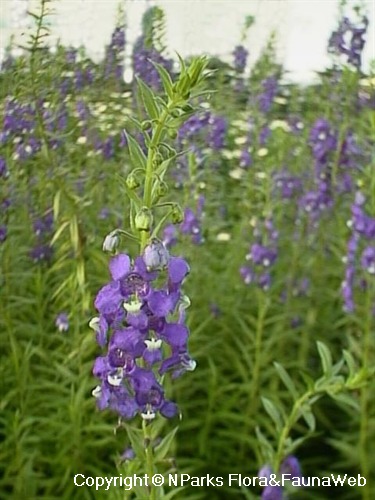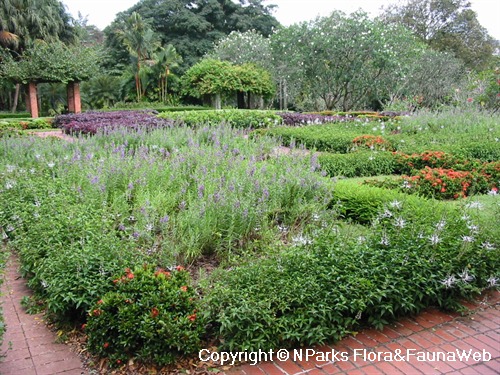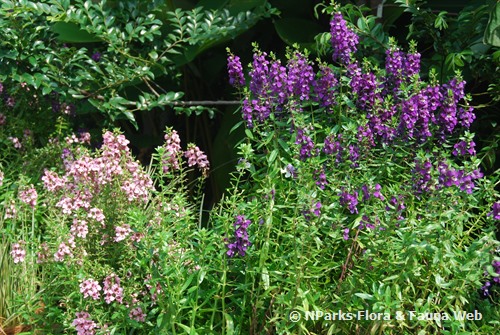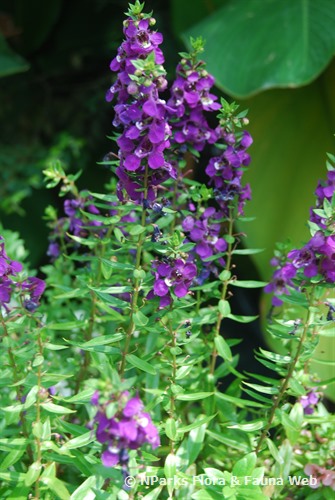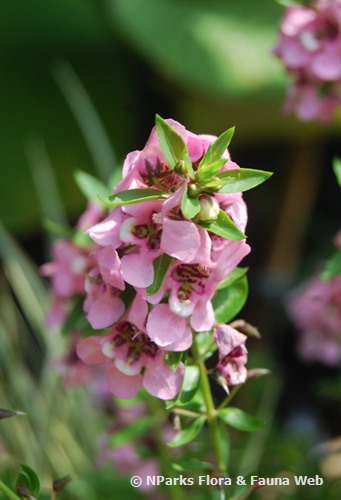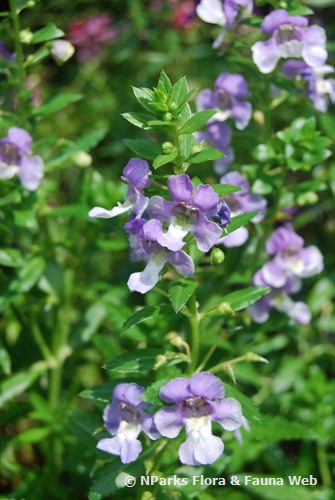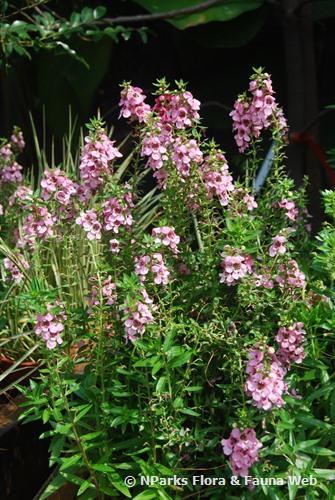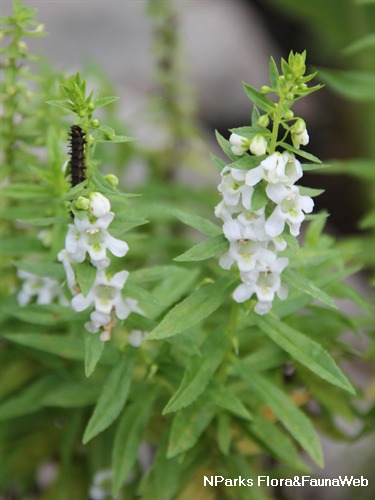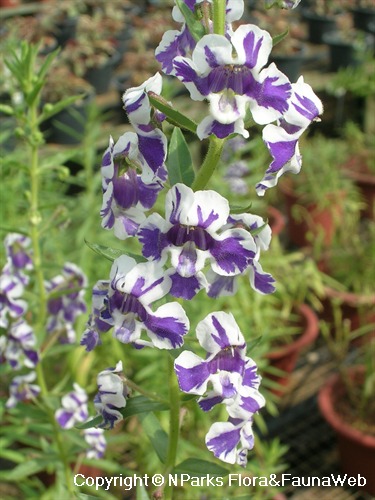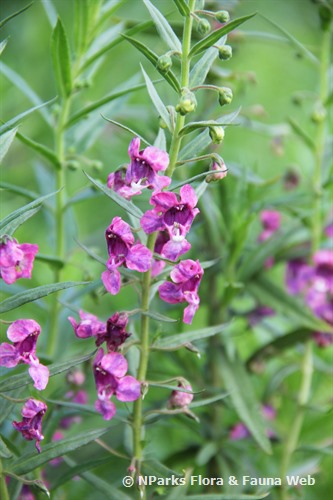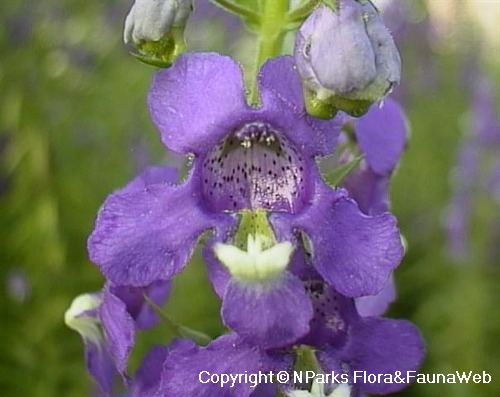
Back
Angelonia angustifolia Benth.
| Family Name: | Plantaginaceae |
| Common Name: | Summer Snapdragon, Angel Flower, Narrow-leaved Angelon, Angelonia, Summer Orchid, 天使花, 蓝天使 |
Name
Classifications and Characteristics
| Plant Division | Angiosperms (Flowering Seed Plants) (Dicotyledon) |
|---|---|
| Plant Growth Form | Herbaceous Plant |
| Lifespan (in Singapore) | Perennial |
| Mode of Nutrition | Autotrophic |
| Plant Shape | Shrubby |
| Maximum Height | 0.6 m |
| Maximum Plant Spread / Crown Width | 0.3 m |
Biogeography
| Native Distribution | Mexico, Guatemala, Cuba |
|---|---|
| Preferred Climate Zone | Tropical |
Description and Ethnobotany
| Growth Form | Perennial herbaecous shrub with upright habit, up to 0.6m height if planted in ground. |
|---|---|
| Foliage | Leaves narrowly linear, with sticky glandular hairs and serrated margins, arranged in opposite pairs, scented like apples or grape soda when rubbed or cut. |
| Flowers | Bluish-purple, fairly large (2-3cm across), produced in erect racemes from leaf axils, last a few days on plant, pollinated by bumblebees, free-blooming year-round. |
| Fruit | Explosive sub-globose brown capsules. |
| Similar | Only 2 species, Angelonia angustifolia and Angelonia integerrima, widely hybridized for commercial production. Several cultivars available with various flower colours. Older non-patented cultivars vary in performance, but newer patented cultivars like the AngelMist™ (from US-based supplier) and Angelface® series (from German supplier) are larger, more vigorous and virus-resistant. |
| Cultivation | Prefers moist but well-drained soils. Relatively drought-tolerant when established, but may suffer leaf-tip burn during long dry spells. Allow soil to dry before watering, avoid using in waterlogged sites or allowing plant to sit in wet soils for prolonged periods -- which can promote bacterial or fungal diseases and plant collapse. Feed monthly with a balanced fertilizer to promote good branching and minimize legginess. Avoid high nitrogen/ammonium fertilizers, which can result in excessive leaf production, weak stems and poor blooming. Remove spent flowers, and hard-prune plants once yearly to encourage a more compact form and vigorous blooming. Leaf tips and stems may be attacked by Loopers (caterpillars of Geometer Moths from the Geometridae family, so-named after their characteristic looping gaits). Propagate by stem-tip cuttings (which root easily in 7-10 days) or seeds. |
| Etymology | Genus epithet 'Angelonia' derived from Angelon, the plant's vernacular name in its native range. Species epithet 'angustifolia' means 'narrow leaf', describing the plant's foliage. |
| Ethnobotanical Uses | Others: Cut flowers ideal for vases or in combination bouquets, long flower shelf-life of 14-18 days, although colours may fade. |
Landscaping Features
| Desirable Plant Features | Ornamental Flowers, Fragrant (Flowers, Foliage) (Time Independent) |
|---|---|
| Landscape Uses | Container Planting, General, Flowerbed / Border |
| Thematic Landscaping | Fragrant / Aromatherapy Garden, Naturalistic Garden |
| Plant & Rootzone Preference or Tolerance Remarks | pH 5.5 - 6.2 |
Fauna, Pollination and Dispersal
| Pollination Method(s) | Biotic (Fauna) (Insects (Bee)) |
|---|
Plant Care and Propagation
| Light Preference | Full Sun |
|---|---|
| Water Preference | Moderate Water |
| Plant Growth Rate | Moderate |
| Rootzone Tolerance | Fertile Loamy Soils, Well-Drained Soils |
| Maintenance Requirements | Moderate |
| Propagation Method | Seed, Stem Cutting |
| Planting Distance | 0 to 0 |
Foliar
| Foliage Retention | Evergreen |
|---|---|
| Mature Foliage Colour(s) | Green |
| Mature Foliage Texture(s) | Hairy / Hirsute, Sticky |
| Foliar Type | Simple / Unifoliate |
| Foliar Arrangement Along Stem | Opposite |
| Foliar Shape(s) | Non-Palm Foliage (Linear) |
| Foliar Venation | Pinnate / Net |
| Foliar Margin | Serrate / Toothed |
| Foliar Apex - Tip | Acuminate |
| Typical Foliar Area | Microphyll ( 2.25cm2 - 20.25 cm2 ) |
| Leaf Area Index (LAI) for Green Plot Ratio | 4.5 (Shrub & Groundcover - Dicot) |
Non - Foliar and Storage
| Stem Type & Modification | Herbaceous |
|---|---|
| Root Type | Underground (Fibrous Root) |
Floral (Angiosperm)
| Flower & Plant Sexuality | Bisexual Flowers |
| Flower Colour(s) | Blue, Purple |
|---|---|
| Flower Symmetry | Bilateral |
| Inflorescence Type | Raceme |
| Flowering Period | Free-Flowering |
| Flowering Habit | Polycarpic |
Image Repository
Others
| Master ID | 370 |
|---|---|
| Species ID | 1666 |
| Flora Disclaimer | The information in this website has been compiled from reliable sources, such as reference works on medicinal plants. It is not a substitute for medical advice or treatment and NParks does not purport to provide any medical advice. Readers should always consult his/her physician before using or consuming a plant for medicinal purposes. |

